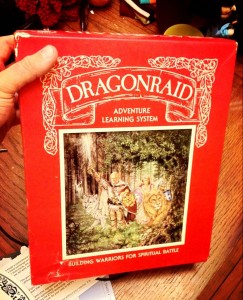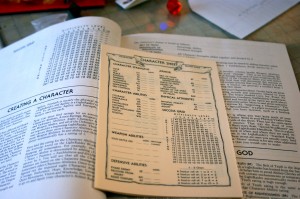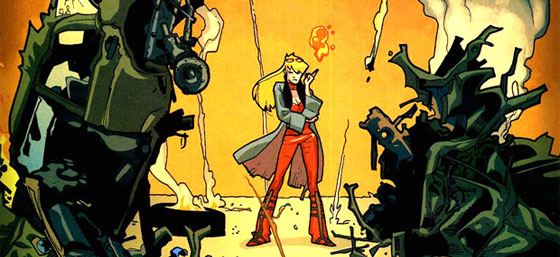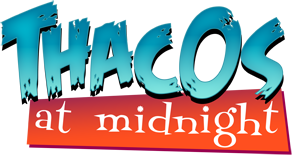
Behold!
You have probably never played Dragonraid. You probably never will. It’s an especially odd duck in a hobby full of odd ducks. It’s a role playing game for Christians, published in 1984 as a safe alternative to Dungeons and Dragons.
I first encountered Dragonraid while attending a Christian school in spring, 1987. I’d just started playing the FASA Doctor Who RPG during lunch hour with a small group of friends. A player’s father expressed concern our games lacked a clear moral compass. And, he was entirely right. The game was full of random death, greed, misanthropy and the usual sorts of stupid stuff that 13-year-old boys come up with when left to their own devices.
Dragonraid was presented to us as an alternative. Not one of those shady “roleplaying games”, but an “Adventure Learning System” that would instil important moral lessons and scriptural familiarity. I was the GM, so the player handed the rulebook over to me for review. I was both fascinated and appalled. I was intrigued by the setting, a weird mix of SF and fantasy, where “monsters,” like Goblins are actually the descendants of criminal aliens.
The PTL Club Renn Faire
The game takes place on a planet called EdenAgain. During the creation of this world by “The Overlord of Many Names,” an evil dragon released an egg onto the planet, which split into nine and became the seed of all unrest and wickedness. Over time, the descendants of dragons born from that first egg gained the upper hand, and the Overlord of Many Names had to sacrifice himself to save the world. Sort of. He came back to life a while later. Let me know if this sounds familiar…
Humanity is divided into two factions. The TwiceBorn, the servants of the Overlord, live in a magical enclave known as the “Liberated Lands.” The Liberated Lands are a small peninsula protected from the dragon dominated lands by a magical mountain chain to the north and a turbulent, misty seas in all other directions. The Liberated Lands are essentially a Renn Faire designed by Jim and Tammy Bakker. TwiceBorn humans are taught that outsiders, the OnceBorn, or Dragonslaves, are miserable slaves. The OnceBorn may have fine stone houses and plentiful food and leisure time, but as they don’t have the saving grace of the Overlord, they are not really happy. They may think they are happy, but they aren’t!

“Roll to Mingle with the Unrighteous!”
The Dragonlands are ruled by nine different breeds of dragon, each race embodying a moral failing or representative of one of the snares of Satan. They once brutalized the humans under their control, but realized that it’s easier to dominate humans when they’re happy. So, they turned to other planets to supply their victims, inviting them to send their wretched, their depraved, their poor addled masses, their revolutionaries, lunatics and criminals. So arrived Orcs, Goblins, Trolls, Ogres, Flusterbeasts and other weird creatures. These races were tortured and further abused by the dragons, and thoroughly Stockholm Syndromed into liking it. They now serve specific roles in the dragon kingdoms. Goblins are sadists, torturers and the like. Orcs are the warriors. Other monsters serve as greedy merchants, spies, and so on.
Too Pagan? And Too Violent?
Two things unsettled me, at age 13. First, the game explicitly states that humans are off limits. If you kill a OnceBorn human, no matter how evil, you’ve failed. However, evil creatures – humanoid monsters – are fair game. Not only are they fair game, God expects you to slaughter some monsters out of hand, regardless of age or infirmity. Killing orcs and goblins in their sleep is specifically condoned and encouraged.
Now, I realize that killing sleeping goblins is an essential part of every 13-year-old boy’s gaming experience. But very few games encourage the behaviour. In D&D, the secular game that lacked the supposed moral compass of Dragonraid, killing sleeping or helpless sentients is an evil act, even if they are goblins. And, the combat system is actually more explicitly violent than D&D, with critical charts that contain, for example, two “groin hit” locations.
The second thing that bothered me was the requirement to memorize scripture passages (“Wordrunes”) to achieve in-game effects. You cannot proceed in any of the modules, as written, without memorizing and parroting verses from the New International Version of the Bible. While the memorization didn’t bother me (at the time), I was bothered by the use of scripture verse as “magic spells.” You want to open the mysterious cave? You need to repeat a verse. All of you.
We decided the game was too violent and too pagan.
Think about that.
We were a quartet of 13-year-old boys at a private Christian school, which one would think was the ideal market for the game. But we thought it was theologically inferior to the Doctor Who game and went back to fighting Daleks. In other words, the game that was given to us as a holy alternative to the violence and magical thinking of Dungeons & Dragons… was full of violence and magical thinking.
Read the rest of this entry »







